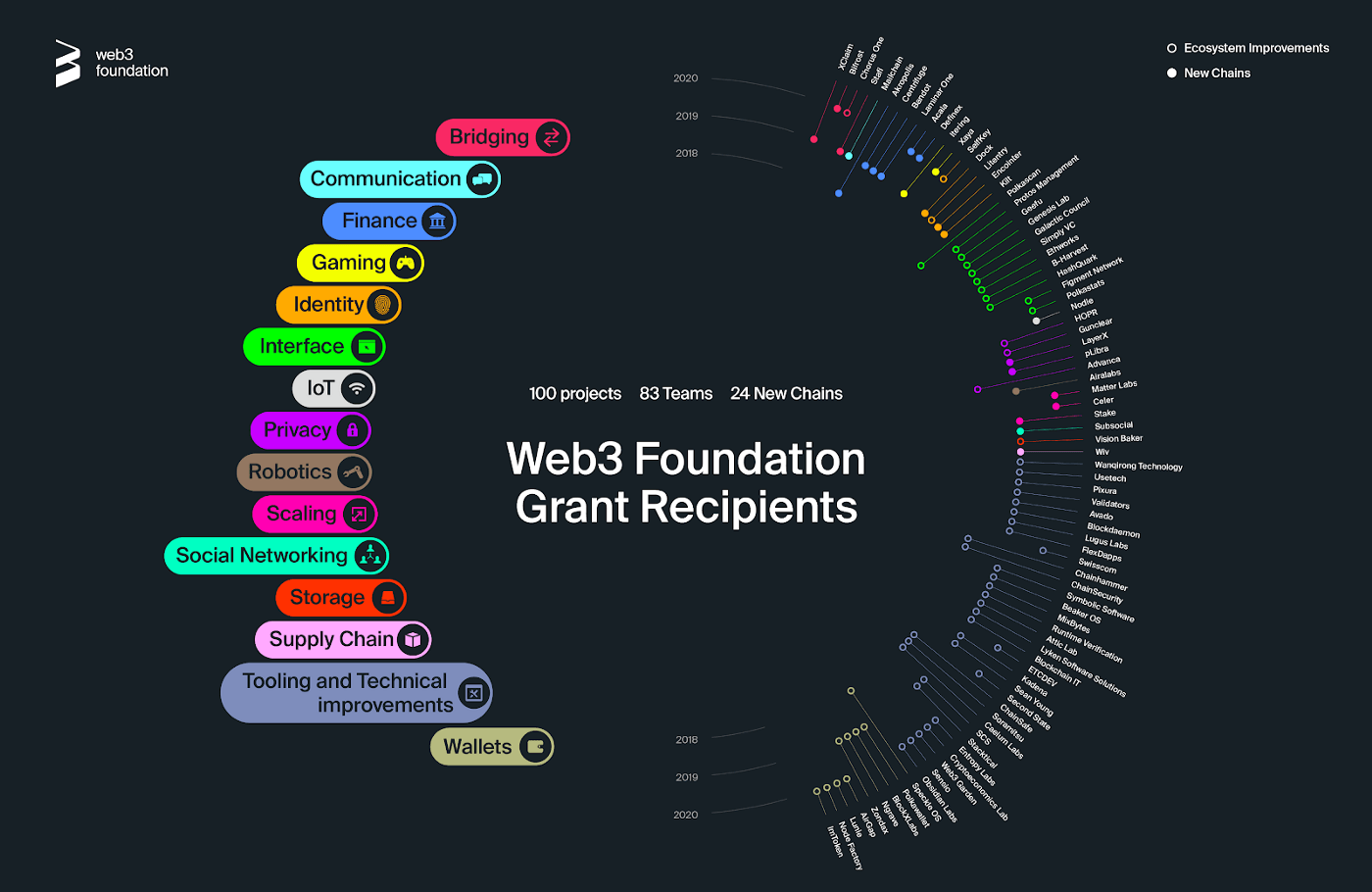 The world of Polkadot (DOT): A 2020 year in review
The world of Polkadot (DOT): A 2020 year in review The world of Polkadot (DOT): A 2020 year in review

Photo by malith d karunarathne on Unsplash
According to Gavin Wood, the founder and lead developer at Polkadot, The ambitious blockchain project has had a hugely successful year and will continue to be the most decentralized network on the market. Wood published a roundup of the company’s achievements in 2020 and shared the company’s plans for next year.
Grant programs and treasuries were a huge success in 2020
According to Wood’s Medium post, the development of Polkadot picked up the pace this year. The blockchain’s Rust codebase now has over half a million lines of code, while its Substrate Technical channel has almost tripled the number of developers in it to 2,600.
This year alone, over 200 projects have been funded through the blockchain’s various grant programs and treasuries—Polkadot’s treasury alone funded a total of 23 proposals with over 118,000 DOT in the last few months alone. The Web3 Foundation’s ongoing grants program has granted $4.1 million to 145 different proposals, Wood said in the post.

The high number of grants are a direct result of a huge percentage of circulating DOT being staked. On the last day of the year, 63 percent of the 1.03 billion DOT in existence are locked into the staking system and another 10.4 million DOT sit in the Polkadot treasury and are ready to be spent on community proposals.
Fast and efficient development also enabled Polkadot itself to launch without any major hiccups this year. In May, the Polkadot launch roadmap was rolled out, marking the beginning of a new era for the blockchain—the claims process was the first thing to roll out, followed by the genesis block of a permissioned PoA network. The launch was ended with a redenomination vote conducted on the fledgling network, essentially enabling the community to decide what the denomination of the DOT token should be in terms of Polkadot’s indivisible unit, the Planck.
After the launch, the number of validators on the network increased significantly, with Polkadot now counting 274 validators, run by around 200 independent operators and backed by over 7,000 individual nominating accounts.
“Polkadot is arguably the most decentralized high-value (and therefore secure) network in existence,” Wood said in his post.
A huge amount of DOT waiting for good proposals
This year marked an important milestone for Polkadot, as it was the year where the blockchain saw its first treasury proposals submitted and approved. Polkadot’s development team is especially proud of its community, with Wood saying that people participating in the network are “taking a healthy interest in Polkadot’s future.”
All that interest is, at least in part, due to the massive amount of money waiting for developers in Polkadot’s treasury. The blockchain’s treasury now has over 10 million DOT, worth over $81 million at press time. Wood said that the money should be a call to action to the community—if it doesn’t get distributed to members through grants, all of the money in the treasury will be slowly burned.
“Propose something great for Polkadot and if the elected council agrees then Polkadot will fund you!” he said.
Aside from preventing the DOT in the treasury from being burned, a higher community engagement will also help Polkadot reach its staking target faster. The “1000 Validator Program” has been launched for Polkadot and backed by the Web3 Foundation’s DOT treasury. Kusama, a multi-chain network for early-stage Polkadot deployments, grew the number of its validators from 700 to 900 this year. Wood said that he expects Polkadot to follow the same trajectory, which requires the network to be run by a minimum of 1,000 validators.
A high number of validators will also attract new users to the platform. In his Medium post, Wood said that one of the biggest goals for Polkadot in the months and years to come is to build bridges between other blockchains.
Interoperability is a major goal for 2021
“While Polkadot is first and foremost a heterogeneous “sharded” multichain, one of Polkadot’s chief aims is to facilitate interoperability,” Wood explained.
The interoperability he is referring to means interoperability both between Polkadot’s own constituent parachains and other blockchain platforms.
While the company plans on connecting to multiple different networks, Ethereum remains its biggest goal. Parity’s Ethereum-Substrate compatibility program called Frontier is now almost completely done. Wood explained that the program will allow any Substrate chain to appear exactly as an Ethereum chain in the most important way, as well as host any tooling such as MetaMask and Truffle that utilize the Web3 RPC.
Aside from Parity’s own Ethereum compatibility effort, two important inter-chain bridges are also being constructed and are set to see the light of day in 2021. One is a bridge between Polkadot and the Bitcoin mainnet, developed by Interlay, while the other is another bridge to Ethereum, but this time developed by Snowfork.
None of this, however, would be possible without the massive effort from the Polkadot community. There are currently well over 100 teams and various projects working either on Polkadot itself or developing solutions built on top of the blockchain. One of the biggest development hubs for Polkadot is most definitely China, which now hosts 30 different teams building systems, projects, and various components for the Polkadot ecosystem.
This, according to Wood, makes Polkadot the second most active DeFi system after Ethereum. He said that Polkadot has the most developer traction and stickiness out of any third-generation blockchain projects, which is why major industry players such as Chainlink and Gitcoin chose it as its next network after Ethereum.
And while this year has probably been the most successful year for Polkadot so far, Wood says that next year will bring even more significant improvements. All of the core technology launched this year will be integrated into the Polkadot mainnet throughout 2021.
“The first few months of 2021 is looking to be a very exciting time for all of us,” Wood said in the post.
Polkadot Market Data
At the time of press 5:35 pm UTC on Dec. 31, 2020, Polkadot is ranked #6 by market cap and the price is up 10.1% over the past 24 hours. Polkadot has a market capitalization of $7.31 billion with a 24-hour trading volume of $2.29 billion. Learn more about Polkadot ›
Crypto Market Summary
At the time of press 5:35 pm UTC on Dec. 31, 2020, the total crypto market is valued at at $754.38 billion with a 24-hour volume of $172.83 billion. Bitcoin dominance is currently at 70.39%. Learn more about the crypto market ›
Disclaimer: CryptoSlate has received a grant from the Polkadot Foundation to produce content about the Polkadot ecosystem. While the Foundation supports our coverage, we maintain full editorial independence and control over the content we publish.



 CryptoQuant
CryptoQuant 
 CoinGlass
CoinGlass 
 Blockchain.com
Blockchain.com 
 Farside Investors
Farside Investors 







































































































